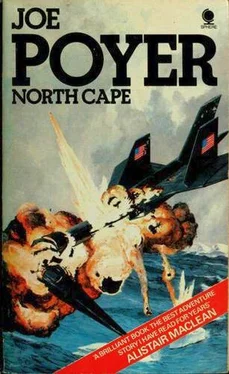And again the Falcon showed up, cutting his flight path on a diagonal that would have the Falcon meet him as he crossed into Soviet territory. Frustrated, Teleman went into a climbing turn east and at Mach 1.8 headed into Sinkiang.
He was holding an altitude of eighty thousand feet — a comfortable level for the A-17 that made the best use of its fuel capacity. It was now obvious to him that the Soviets had developed some type of sophisticated, visual tracking system that could not only pick him out at great altitudes and distances, but hold him at supersonic speeds as a Falcon closed. A visual tracking system would require a second man in the aircraft; this probably explained the limited stay-time. The increased payload taken up by the observer and the visual tracking equipment would cut well into the cruising range of the Falcon. Although it was designed for long supersonic flight, it could sustain its Mach 4.8 speed only for short durations, for the approach and attack. During the cruise to and from the target, the speed would be well down into the more conventional ranges. But the problem confronting Teleman now was: At what range could they track him? Did they have to have flying patrols in the air, or did they have ground observing stations with much more sensitive equipment than an aircraft could possibly carry?
The Soviets could have had plenty of opportunity to observe him while he was orbiting the fire fight involving the trucks, as well as during his pass across the valley where the shell had impacted.
That in turn led him to the next series of questions. Did they know about the A-17?
Obviously they did. A visual tracking system sophisticated enough to pick up what amounted to a flyspeck moving at speeds up to Mach 4.5 over even several hundred miles distance would require a substantial outlay of both men and money. And to have set-up in the vicinity of the Soviet-Chinese war zone, they would have had to know that the conflict would bring him on the run. There was nothing the Chinese could put into the sky that would require a visual tracking system. Teleman shook his head. It was all such a preposterous chain of events, but then so was the U-2 flight that was shot down over Russia in late 1959, by a missile whose existence was not even suspected by Western intelligence. And so vicious was the pace of missile development that in 1965, up-rated, second-generation versions of those same missiles were provided to the North Vietnamese for use against U.S. fighter-bombers as obsolete Soviet weaponry. The Soviets could very well have rushed the development of a visual tracking system in much the same way that they and the United States always had when a clear requirement arose. A-17 flights had been going on over Soviet territory for more than a year now, and the increasing appearance of dead spots in radar warning and detection systems would be enough to indicate that something or someone was intruding over Soviet territory with alarming frequency. Even if they had not been particularly worried about intelligence-gathering missions, they would be seared to death that the same ECM systems could be placed in manned bombers or even intercontinental missiles. So the knowledge that the Soviets were onto the A-17 overflights, and onto them with a visual tracking system, was suddenly more important than the information he had gathered from the war zone. The problem was how to get the information back to Washington.
By now he was six hundred miles into the northern reaches of Sinkiang and less than ten minutes from the Mongolian border. Mongolia was still firmly in the Soviet camp, perhaps not firmly enough to have the new Falcons, but it was not worth the risk of finding out. Coming up dead ahead was the faint thread of the Irtysh River. The floor of the desert was as deserted as only the
Gobi could be. In this particular area not even Mongolian herdsman could live. The river, here near its headwaters in the low hills that lay two hundred miles off his starboard wing, was still little more than a muddy stream, not yet purified and strengthened as it would be later on during its 2500-mile rush to the Arctic Ocean. South, the Gobi cut into the province of Sinkiang, cut a swatch of utter desolation for another five hundred miles before the land began the long climb back to the fertile steppes leading to the Tien Shan, whose eastern flank’s began on the far side of the Turfan Depression. Teleman punched the tabs to key in the ground control maps of the Tien Shan. When the image centered, he stopped the flow and asked for the altitude overlay, then settled back to study the lofty summits. The Tien Shan was actually the northern extension of the Himalaya chain, reaching north and east for nearly fifteen hundred miles. Next to the Himalayas, the Tien Shan was the longest mountain chain on the Asian continent. The southern slopes on the west rose out of the Pamir Plateau and covered more than four hundred thousand square miles. It was a cinch that the Soviets would not be able to cover the entire range with visual tracking equipment. But he still did not know the altitude range of that equipment. And the Soviets would be expecting him to try and break through somewhere. They must know, or at least suspect, that he had to recross Soviet territory. And he did, he thought ruefully. Normally he would fly out of the fix by crossing China and refueling over either the Bay of Bengal or the China Sea. But not this time. They must have been watching the progress of the blind spots on the radar screens as he crossed Soviet territory, making educated guesses with their computers until they hit upon a familiarity with his flight schedules. He had no support waiting anywhere except in the Barents Sea. The mission was too complex and the secrecy too great to try and stretch it to alternate points. Each flight was carefully made up and very little margin of error allowed. He had no alternate landing bases outside the continental United States. No landings in foreign territory could be allowed. If he had to abort a mission, he was to head for the nearest ocean and bail out.
So this mission, it was back to the Barents Sea or not at all. Teleman decided that the risk of crossing Soviet territory with the information he had so far collected justified the attempt
As he continued to study the map of the Tien Shan, a plan began to take shape. The range averaged 250 miles wide and the peaks ranged up,to 23,620 feet in the Tengri Khan, in the center, to 17,946 in the Bogodo Ula in the east. A good chunk of the range was glaciated or thickly forested. For the most part, the average elevation ran close to twenty thousand feet, and, located as it was on the edge of both the Gobi Desert and the Himalayas, the interior slopes on the southern face would be sparsely inhabited. Teleman leaned forward and began setting up a flight plan that would carry him directly south of his present position to the vicinity of the Turfan Depression. There he would drop to fifteen thousand feet and wriggle in between the northern flanks of the Altyn Tagh Mountains in the Kun Lun range on the northern reaches of the Himalayas and the Tien Shan. At fifteen thousand feet he would be able carefully to pick his way through the valleys and canyons of the Tien Shan and come out far south of the war zone, thus crossing the border at 49° latitude into Kirghiz SSR. By staying down on the deck through the mountains, it would be impossible for the Soviets to track his progress. Teleman hoped only that by now, six hundred miles into Sinkiang, he was well off their scopes. Seconds later, after checking fuel levels, the computer agreed with the revised flight plan. It would be cutting it fine, he decided, but it could be done without having to touch the fuel reserves. And, as a bonus, it would put him less than ten minutes off the rendezvous schedule he had set up with Larkin.
Читать дальше












